Popular categories
Looking for a yarn?

50% Wool, 25% Alpaca, 25% Viscose
from 22.00 RON /50g
Order DROPS Kid-Silk from Andrele

|
DROPS Kid-Silk uni colour 75% Mohair, 25% Silk |
25.00 RON /25g |
Order |
Clicking the ORDER button will redirect you to Andrele website
The yarn cost is calculated from the pattern’s smallest size and the yarn’s cheapest product type. Looking for an even better price? You might find it on the DROPS Deals!
Sweet Weekend
Knitted jumper in 1 strand DROPS Soft Tweed and 2 strands DROPS Kid-Silk. The piece is worked top down with stocking stitch, European shoulder / diagonal shoulders and high neck. Sizes S - XXXL.
DROPS Design: Pattern st-026
Yarn group B + A + A
-------------------------------------------------------
SIZES:
S - M - L - XL - XXL - XXXL
MATERIALS:
DROPS SOFT TWEED from Garnstudio (belongs to yarn group B)
300-350-350-400-450-500 g colour 02, marzipan
DROPS KID-SILK from Garnstudio (belongs to yarn group A)
100-100-125-125-150-150 g colour 40, pink pearl
DROPS KID-SILK from Garnstudio (belongs to yarn group A)
100-100-125-125-150-150 g colour 41, powder
NEEDLES:
DROPS CIRCULAR NEEDLE SIZE 7 MM: Length 40 cm and 80 cm.
DROPS CIRCULAR NEEDLE SIZE 6 MM: Length 40 cm and 80 cm.
DROPS DOUBLE POINTED NEEDLES SIZE 7 MM.
DROPS DOUBLE POINTED NEEDLES SIZE 6 MM.
The technique MAGIC LOOP can be used – you then only need circular needle of 80 cm in each size.
KNITTING TENSION:
14 stitches in width and 17 rows in height with stocking stitch and 3 strands = 10 x 10 cm.
NOTE: Needle size is only a guide. If you get too many stitches on 10 cm, change to a larger needle size. If you get too few stitches on 10 cm, change to a smaller needle size.
-------------------------------------------------------
Alternative Yarn – See how to change yarns here
Yarn Groups A to F – Use the same pattern and change the yarn here
Yarn usage using an alternative yarn – Use our yarn converter here
-------------------------------------------------------

50% Wool, 25% Alpaca, 25% Viscose
from 22.00 RON /50g
Order DROPS Soft Tweed from Andrele

|
DROPS Kid-Silk uni colour 75% Mohair, 25% Silk 25.00 RON /25g Order |
Clicking the ORDER button will redirect you to Andrele website
The yarn cost is calculated from the pattern’s smallest size and the yarn’s cheapest product type. Looking for an even better price? You might find it on the DROPS Deals!
- English (UK/cm), Romania
- Česky
- Dansk
- Deutsch
- Eesti keel
- English (UK/cm)
- English (US/in)
- Español
- Français
- Íslenska
- Italiano
- Magyar
- Nederlands
- Norsk
- Polski
- Português
- Suomi
- Svenska
- English (UK/cm), Bulgaria
- English (UK/cm), Croatia
- English (UK/cm), Greece
- English (UK/cm), Latvia
- English (UK/cm), Lithuania
- English (UK/cm), Slovenia
- Česky, Slovakia
Pattern instructions
EXPLANATIONS FOR THE PATTERN:
-------------------------------------------------------
INCREASE TIP FROM THE RIGHT SIDE:
Increase towards the left AFTER MARKER:
Use left needle to pick up thread between 2 stitches from row below, pick up thread from front and knit stitch in back loop.
Increase towards the right BEFORE MARKER:
Use left needle to pick up thread between 2 stitches from row below, pick up thread from behind and knit stitch in front loop.
INCREASE TIP FROM THE WRONG SIDE:
Increase towards the left AFTER MARKER:
Use left needle to pick up thread between 2 stitches from row below, pick up thread from behind and purl stitch in front loop.
Increase towards the right BEFORE MARKER:
Use left needle to pick up thread between 2 stitches from row below, pick up thread from front and purl stitch in back loop.
DECREASE TIP (for sleeves):
Decrease 1 stitch on either side of the marker as follows: Work until there are 3 stitches left before the marker, knit 2 together, knit 2 (marker sits between these 2 stitches), slip 1 stitch as if to knit, knit 1 and pass the slipped stitch over the knitted stitch.
-------------------------------------------------------
START THE PIECE HERE:
-------------------------------------------------------
JUMPER – SHORT OVERVIEW OF THE PIECE:
The back piece is worked back and forth with circular needle, top down until the armholes are finished. Stitches are knitted up on each shoulder and increased for the neck, then the front piece is worked back and forth with circular needle, top down until the armholes are finished.
The front and back pieces are joined and the body continued in the round with circular needle. Stitches are knitted up around the armholes, the sleeve-cap is worked back and forth then the rest of the sleeve is worked in the round with short circular needle/double pointed needles. The neck is worked in the round to finish.
BACK PIECE:
Cast on 26-28-28-30-32-32 stitches with circular needle size 7 mm and 1 strand DROPS Soft Tweed and 2 strands DROPS Kid-Silk (3 strands).
Purl 1 row from the wrong side.
Insert 1 marker inside 3 stitches on each side. The markers should sit inside the 3 outermost stitches on every row onwards.
Work stocking stitch back and forth.
AT THE SAME TIME increase AFTER the marker at the beginning of the first row from the right side) and BEFORE the marker at the end of the row – read INCREASE TIP FROM THE RIGHT SIDE.
On the next row (wrong side) increase in the same way – read INCREASE TIP FROM THE WRONG SIDE.
Increase from both the right and wrong side a total of 26-28-30-32-32-34 times. After the last increase there are 78-84-88-94-96-100 stitches.
The piece is measured from here!
Continue with stocking stitch until the piece measures 15-15-16-17-18-19 cm (measured outermost along the armhole). Cut the yarn, lay the piece to one side on a thread or on an extra needle and work the front piece.
FRONT PIECE:
Start with the left shoulder (when the garment is worn).
Knit up 26-28-30-32-32-34 stitches along the left shoulder on the back piece, inside the outermost stitch (i.e. knit up 1 stitch in each row along the top). Work stocking stitch back and forth for 5 cm. Now increase for the neck after the first 3 stitches at the beginning of each row from the right side – remember INCREASE TIP FROM THE RIGHT SIDE: Increase 1 stitch 4 times = 30-32-34-36-36-38 stitches. Purl 1 row from the wrong side. Cut the yarn, lay the piece to one side on a thread or an extra needle. Work the right shoulder as follows:
Knit up 26-28-30-32-32-34 stitches along the right shoulder on the back piece, inside the outermost stitch. Work stocking stitch back and forth for 5 cm. Now increase for the neck before the last 3 stitches at the end of each row from the right side – remember INCREASE TIP FROM THE RIGHT SIDE: Increase 1 stitch 4 times = 30-32-34-36-36-38 stitches. Purl back from the wrong side after the last increase.
Work as follows from the right side: Knit the 30-32-34-36-36-38 stitches from the right front piece, cast on 18-20-20-22-24-24 stitches for the neck and knit the 30-32-34-36-36-38 stitches from the left front piece = 78-84-88-94-96-100 stitches.
Work stocking stitch back and forth until the piece measures 23-25-26-27-28-29 cm down the armhole.
BODY:
Work the 78-84-88-94-96-100 stitches from the front piece, cast on 4-6-8-8-14-18 at the end of the row (side), work the 78-84-88-94-96-100 stitches from the back piece, cast on 4-6-8-8-14-18 stitches at the end of the row = 164-180-192-204-220-236 stitches.
Work stocking stitch in the round until the piece measures 48-50-52-54-56-58 cm, from the highest point on the front shoulder. Change to circular needle size 6 mm. Knit 1 round and increase 16-16-16-16-20-20 stitches evenly spaced = 180-196-208-220-240-256 stitches. Work rib (knit 2, purl 2) for 10 cm. Cast off. The jumper measures approx. 58-60-62-64-66-68 cm, measured from the top of the shoulder.
LEFT SLEEVE:
Use circular needle size 7 mm, 1 strand DROPS Soft Tweed and 2 strands DROPS Kid-Silk (3 strands). Knit up from the right side 33-35-36-38-40-41 stitches from the bottom of the armhole and up the front piece to the shoulder, then 21-21-22-24-24-27 stitches down the back piece to the bottom of the armhole = 54-56-58-62-64-68 stitches. Insert 1 marker in the middle of the row – the sleeve is measured from this marker.
Work stocking stitch back and forth for 1-2-3-3-4-6 cm.
Now join the sleeve using circular needle/double pointed needles size 7 mm. Insert 1 marker at the beginning of the round (mid-under sleeve). Allow the marker to follow your work onwards.
Start at the marker and work stocking stitch in the round until the sleeve measures 4-4-4-4-5-7 cm, now decrease 2 stitches mid-under the sleeve – read DECREASE TIP.
Decrease like this every 5-5-5-4-4-3 cm a total of 6-6-6-7-7-8 times = 42-44-46-48-50-52 stitches.
Continue working until the sleeve measures 34-34-34-33-33-33 cm from the marker. There is 10 cm left. Try the jumper on and work to desired length. Knit 1 round and increase 2-4-2-4-2-4 stitches evenly spaced = 44-48-48-52-52-56 stitches. Change to double pointed needles size 6 mm. Work rib (knit 2, purl 2) for 10 cm. Cast off a little loosely. The sleeve measures approx. 44-44-44-43-43-43 cm from the marker.
RIGHT SLEEVE:
Work the in the same way as the left sleeve, but knit up 21-21-22-24-24-27 stitches from the bottom of the armhole up the back piece and 33-35-36-38-40-41 stitches from the shoulder down the front piece to the bottom of the armhole. Sew the bottom of the armhole together – see sketch.
NECK:
Start on one shoulder and knit up from the right side, inside the 1 edge stitch, 68 to 84 stitches using short circular needle size 6 mm and 3 strands. The stitch-number should be divisible by 4. Work rib in the round (knit 2, purl 2) for 22-22-22-24-24-24 cm. Cast off a little loosely.
Diagram

|
= Sew the bottom of the armhole together: Sew b to B |


What can you do with our patterns? You can share DROPS patterns online, using the pattern original picture, materials, name and number. But you are NOT ALLOWED to reproduce the complete pattern digitally in any way. Yarn stores are welcome to use the DROPS pattern database to promote the sale of our assortment. You can print out our patterns, make as many copies as you’d like. The only thing we ask is that you don't make any changes / additions to the original printed document. And that the patterns according to the DROPS philosophy are given out to the consumers for free. Editorials that wish to publish our patterns in printed books or magazines can contact us for more information. The sale of garments based on DROPS patterns is permitted as long as they are sold as single items or per order. Further commercial use of the patterns is not permitted. It has to be clearly stated that the garment is made based on a design from DROPS DESIGN. The use of clothing labels of which DROPS DESIGN forms part is conditioned by the inclusion of the following text: “A DROPS DESIGN made by …..”. The use of DROPS photos for marketing purposes/sales is only permitted in connection with the use/sale of DROPS products. The photos may not be cut or edited and the logo should be clearly visible.
We reserve the right to withdraw the permission for use of our patterns at any time, notwithstanding the reason.
Each of our patterns has specific tutorial videos to help you.
These step-by-step tutorials might also help you:
Why is the knitting/crochet tension so important?
Knitting tension is what determines the final measurements of your work, and is usually measured per 10 x 10 cm. It is provided like so: number of stitches in width x number of rows in height - eg: 19 stitches x 26 rows = 10 x 10 cm.
The knitting tension is very individual; some people knit/crochet loosely while others work tightly. You adjust the knitting tension with the needle size, which is why the suggested needle size is only meant as a guide! You need to adjust this (up or down) to ensure that YOUR knitting tension matches the knitting tension provided in the pattern. If you work with a different knitting tension than provided you will have a different yarn consumption, and your work will have different measurements than what the pattern suggests.
The knitting tension also determines which yarns can replace each other. As long as you achieve the same knitting tension you can replace one yarn with another.
See DROPS lesson: How to measure your tension/gauge
See DROPS video: How to make a gauge tension swatch
How do I know how many balls of yarn I need?
The required amount of yarn is provided in grams, eg: 450 g. To calculate how many balls you’ll need you first need to know how many grams are in 1 ball (25g, 50g or 100g). This information is available if you click on the individual yarn quality on our pages. Divide the amount required with the amount of each ball. For example, if each ball is 50g (the most common amount), the calculation will be as follows: 450 / 50 = 9 balls.
Can I use a different yarn than what the pattern suggests?
The important thing when changing from one yarn to another is that the knitting/crochet tension remains the same. This is so that the measurements of the finished piece will be the same as on the sketch provided. It is easier to achieve the same knitting tension using yarns from the same yarn group. It is also possible to work with multiple strands of a thinner yarn to achieve the knitting tension of a thicker one. Please try our yarn converter. We recommend you to always work a test swatch.
Please NOTE: when changing yarn the garment might have a different look and feel to the garment in the photo, due to individual properties and qualities of each yarn.
See DROPS lesson: Can I use a different yarn than the one mentioned in the pattern?
What are the yarn groups?
All our yarns are categorised into yarn groups (from A to F) according to thickness and knitting tension – group A contains the thinnest yarns and group F the thickest. This makes it easier for you to find alternative yarns to our patterns, should you wish to switch yarn. All yarns within the same group have a similar knitting tension and can easily replace each other. However, different yarn qualities have different structures and properties which will give the finished work a unique look and feel.
How do I use the yarn calculator?
At the top of all our patterns you’ll find a link to our yarn calculator, which is a helpful tool should you wish to use a different yarn than suggested. By filling in the yarn quality you wish to replace, the amount (in your size) and number of strands, the calculator will present good alternative yarns with the same knitting tension. Additionally it will tell you how much you’ll require in the new qualities and whether you’ll need to work with multiple strands. Most skeins are 50g (some are 25g or 100g).
If the pattern is worked with multiple colours, every colour will have to be calculated separately. Similarly, if the pattern is worked with several strands of different yarns (for example 1 strand Alpaca and 1 strand Kid-Silk) you will have to find alternatives for each, individually.
Why do you show discontinued yarns in the patterns?
Since different yarns have different qualities and textures we have chosen to keep the original yarn in our patterns. However, you can easily find options among our available qualities by using our yarn calculator, or simply pick a yarn from the same yarn group.
It is possible that some retailers still have discontinued yarns in stock, or that someone has a few skeins at home that they would like to find patterns for.
The yarn calculator will provide both alternative yarn as well as required amount in the new quality.
What size should I knit?
If you think it's hard to decide what size to make, it can be a good idea to measure a garment you own already and like the size of. Then you can pick the size by comparing those measures with the ones available in the pattern's size chart.
You'll find the size chart at the bottom of the pattern.
See DROPS lesson: How to read size chart
Why do I get the wrong knitting tension with the suggested needle size?
The needle size provided in the pattern serves only as a guide, the important thing is to follow the knitting tension. And since knitting tension is very individual, you will have to adjust the needle size to ensure that YOUR tension is the same as in the pattern – maybe you’ll have to adjust 1, or even 2 needle sizes, up or down to achieve the correct tension. For this, we recommend that you work test swatches.
Should you work with a different knitting tension than the one provided, the measurements of the finished garment might deviate from the measurement sketch.
See DROPS lesson: How to measure your tension/gauge
See DROPS video: How to make a tension/gauge swatch
Why is the pattern worked top-down?
Working a garment top-down provides more flexibility and room for personal adjustment. For example it is easier to try the garment on while working, as well as making adjustments to length of yoke and shoulder caps.
The instructions are carefully explaining every step, in the correct order. Diagrams are adjusted to the knitting direction and are worked as usual.
How do I work according to a knitting diagram?
The diagram depicts all rows/rounds, and every stitch seen from the right side. It is read from bottom to top, from right to left. 1 square = 1 stitch.
When working back and forth, every other row is worked from the right side and every other row is worked from the wrong side. When working from the wrong side, the diagram will have to be worked reversed: from left to right, knit stitches are purled, purl stitches are knit etc.
When working in the round every round is worked from the right side and the diagram are worked from right to left on all rounds.
See DROPS lesson: How to read knitting diagrams
How do I work according to a crochet diagram?
The diagram depicts all rows/rounds, and every stitch seen from the right side. It is worked from bottom to top, from right to left.
When working back and forth every other row is worked from the right side: from right to left and every other row is worked from the wrong side: from left to right.
When working in the round, every row in the diagram are worked from the right side, from right to left.
When working a circular diagram you start in the middle and work your way outwards, counter clockwise, row by row.
The rows usually start with a given number of chain stitches (equivalent to the height of the following stitch), this will either be depicted in the diagram or explained in the pattern.
See DROPS lesson: How to read crochet diagrams
How do I work several diagrams simultaneously on the same row/round?
Instructions for working several diagrams after each other on the same row/round, will often be written like so: “work A.1, A.2, A.3 a total of 0-0-2-3-4 times". This means you work A.1 once, then A.2 is worked once, and A.3 is repeated (in width) the number of times provided for your size – in this case like so: S = 0 times, M = 0 times, L=2 times, XL= 3 times and XXL = 4 times.
The diagrams are worked as usual: begin with the first row in A.1, then work the first row in A.2 etc.
See DROPS lesson: How to read knitting diagrams
See DROPS lesson: How to read crochet diagrams
Why are the sleeves shorter in larger sizes?
The total width of the garment (from wrist-to-wrist) will be larger in the larger sizes, despite the actual sleeves being shorter. The larger sizes have longer sleeve caps and wider shoulders, so there will be a good fit in all sizes.
Where on the garment is the length measured?
The measurement sketch/schematic drawing provides information regarding the full length of the garment. If it’s a jumper or a jacket the length is measured from the highest point on the shoulder closest to the neckline, and straight down to the bottom of the garment. It is NOT measured from the tip of shoulder. Similarly, the length of yoke is measured from the highest point on the shoulder and down to where yoke is split into body and sleeves.
On a jacket measures are never taken along bands, unless specifically stated. Always measure inside band stitches when measuring the length.
See DROPS lesson: How to read a schematic drawing
What is a repeat?
Diagrams are often repeated on the round or in height. 1 repeat is the diagram the way it appears in the pattern. If it says to work 5 repeats of A.1 in the round, then you work A.1 a total of 5 times after/next to each other in the round. If it says to work 2 repeats of A.1 vertically/in height you work the entire diagram once, then begin again at the start and work the entire diagram one more time.
Why does the piece start with more chain stitches than it’s worked with?
Chain stitches are slightly narrower than other stitches and to avoid working the cast-on edge too tight, we simply chain more stitches to begin with. The stitch count will be adjusted on the following row to fit the pattern and measurement sketch.
Why increase before the rib edge when the piece is worked top-down?
The rib edge is more elastic and will contract slightly compared to, for example, stocking stitch. By increasing before the rib edge, you avoid a visible difference in width between the rib edge and the rest of the body.
Why increase in the cast-off edge?
It’s very easy to cast off too tightly, and by making yarn overs while casting off (and simultaneously casting these off) you avoid a too tight cast off edge.
See DROPS video: How to bind off with yarn overs (yo)
How do I increase/decrease on every 3rd and 4th row/round alternately?
To achieve an even increase (or decrease) you can increase on, for example: every 3rd and 4th row alternately, like so: work 2 rows and increase on the 3rd row, work 3 rows and increase on the 4th. Repeat this until the increase is complete.
See DROPS lesson: Increase or decrease 1 st on every 3rd and 4th row alternately
How can I work a jacket in the round instead of back and forth?
Should you prefer to work in the round instead of back and forth, you may of course adjust the pattern. You’ll need to add steeks mid-front (usually 5 stitches), and follow the instructions. When you would normally turn and work from the wrong side, simply work across the steek and continue in the round. At the end you’ll cut the piece open, pick up stitches to work bands, and cover the cut edges.
See DROPS video: How to knit steeks and cut open
Can I work a jumper back and forth instead of in the round?
Should you prefer to work back and forth instead of in the round, you may of course adjust the pattern so you work the pieces separately and then assemble them at the end. Divide the stitches for the body in 2, add 1 edge stitch in each side (for sewing) and work the front and back pieces separately.
See DROPS lesson: Can I adapt a pattern for circular needles into straight needles?
Why is the pattern slightly different than what I see in the photo?
Pattern repeats can vary slightly in the different sizes, in order to get the correct proportions. If you’re not working the exact same size as the garment in the photo, yours might deviate slightly. This has been carefully developed and adjusted so that the complete impression of the garment is the same in all sizes.
Make sure to follow instructions and diagrams for your size!
How do I make a women’s size garment into a men’s size one?
If you have found a pattern you like which is available in women’s size it’s not very difficult to convert it to men’s size. The biggest difference will be the length of sleeves and body. Start working on the women size that you think would fit across the chest. The additional length will be worked right before you cast off for the armhole/sleeve cap. If the pattern is worked top-down you can add the length right after the armhole or before the first decrease on sleeve.
Regarding additional yarn amount, this will depend on how much length you add, but it is better with a skein too many than too few.
How do I prevent a hairy garment from shedding?
All yarns will have excess fibres (from production) that might come off as lint or shedding. Brushed yarns (ie hairier yarns) have more of these loose, excess fibres, causing more shedding.
Shedding also depends on what is worn under or over the garment, and whether this pulls at the yarn fibres. It’s therefore not possible to guarantee that there will be no shedding
Below are some tips on how to get the best result when working with hairier yarns:
1. When the garment is finished (before you wash it) shake it vigorously so the looser hairs come off. NOTE: do NOT use a lint roller, brush or any method that pulls at the yarn.
2. Place the garment in a plastic bag and put it in your freezer - the temperature will cause the fibres to become less attached to each other, and excess fibres will come off easier.
3. Leave in the freezer for a few hours before taking it out and shaking it again.
4. Wash the garment according to the instructions on the yarn label.
Why does my garment pill?
Pilling is a natural process that happens to even the most exclusive of fibers. It's a natural sign of wear and tear that is hard to avoid, and that is most visible in high friction areas of your garment like a sweater's arms and cuffs.
You can make your garment look as new by removing the pilling, using a fabric comb or a pill/lint remover.
In the meantime, you can read the questions and answers that others have left to this pattern or join the DROPS Workshop on Facebook to get help from fellow knitters/crocheters!
You might also like...
Sweet Weekend
Sweet Weekend
Sweet Weekend
Sweet Weekend
Sweet Weekend
Sweet Weekend
Sweet Weekend
Sweet Weekend
Sweet Weekend
Sweet Weekend
Sweet Weekend |
||||
 |
 |
|||
Knitted jumper in 1 strand DROPS Soft Tweed and 2 strands DROPS Kid-Silk. The piece is worked top down with stocking stitch, European shoulder / diagonal shoulders and high neck. Sizes S - XXXL.
DROPS 237-2 |
||||
|
------------------------------------------------------- EXPLANATIONS FOR THE PATTERN: ------------------------------------------------------- INCREASE TIP FROM THE RIGHT SIDE: Increase towards the left AFTER MARKER: Use left needle to pick up thread between 2 stitches from row below, pick up thread from front and knit stitch in back loop. Increase towards the right BEFORE MARKER: Use left needle to pick up thread between 2 stitches from row below, pick up thread from behind and knit stitch in front loop. INCREASE TIP FROM THE WRONG SIDE: Increase towards the left AFTER MARKER: Use left needle to pick up thread between 2 stitches from row below, pick up thread from behind and purl stitch in front loop. Increase towards the right BEFORE MARKER: Use left needle to pick up thread between 2 stitches from row below, pick up thread from front and purl stitch in back loop. DECREASE TIP (for sleeves): Decrease 1 stitch on either side of the marker as follows: Work until there are 3 stitches left before the marker, knit 2 together, knit 2 (marker sits between these 2 stitches), slip 1 stitch as if to knit, knit 1 and pass the slipped stitch over the knitted stitch. ------------------------------------------------------- START THE PIECE HERE: ------------------------------------------------------- JUMPER – SHORT OVERVIEW OF THE PIECE: The back piece is worked back and forth with circular needle, top down until the armholes are finished. Stitches are knitted up on each shoulder and increased for the neck, then the front piece is worked back and forth with circular needle, top down until the armholes are finished. The front and back pieces are joined and the body continued in the round with circular needle. Stitches are knitted up around the armholes, the sleeve-cap is worked back and forth then the rest of the sleeve is worked in the round with short circular needle/double pointed needles. The neck is worked in the round to finish. BACK PIECE: Cast on 26-28-28-30-32-32 stitches with circular needle size 7 mm and 1 strand DROPS Soft Tweed and 2 strands DROPS Kid-Silk (3 strands). Purl 1 row from the wrong side. Insert 1 marker inside 3 stitches on each side. The markers should sit inside the 3 outermost stitches on every row onwards. Work stocking stitch back and forth. AT THE SAME TIME increase AFTER the marker at the beginning of the first row from the right side) and BEFORE the marker at the end of the row – read INCREASE TIP FROM THE RIGHT SIDE. On the next row (wrong side) increase in the same way – read INCREASE TIP FROM THE WRONG SIDE. Increase from both the right and wrong side a total of 26-28-30-32-32-34 times. After the last increase there are 78-84-88-94-96-100 stitches. The piece is measured from here! Continue with stocking stitch until the piece measures 15-15-16-17-18-19 cm (measured outermost along the armhole). Cut the yarn, lay the piece to one side on a thread or on an extra needle and work the front piece. FRONT PIECE: Start with the left shoulder (when the garment is worn). Knit up 26-28-30-32-32-34 stitches along the left shoulder on the back piece, inside the outermost stitch (i.e. knit up 1 stitch in each row along the top). Work stocking stitch back and forth for 5 cm. Now increase for the neck after the first 3 stitches at the beginning of each row from the right side – remember INCREASE TIP FROM THE RIGHT SIDE: Increase 1 stitch 4 times = 30-32-34-36-36-38 stitches. Purl 1 row from the wrong side. Cut the yarn, lay the piece to one side on a thread or an extra needle. Work the right shoulder as follows: Knit up 26-28-30-32-32-34 stitches along the right shoulder on the back piece, inside the outermost stitch. Work stocking stitch back and forth for 5 cm. Now increase for the neck before the last 3 stitches at the end of each row from the right side – remember INCREASE TIP FROM THE RIGHT SIDE: Increase 1 stitch 4 times = 30-32-34-36-36-38 stitches. Purl back from the wrong side after the last increase. Work as follows from the right side: Knit the 30-32-34-36-36-38 stitches from the right front piece, cast on 18-20-20-22-24-24 stitches for the neck and knit the 30-32-34-36-36-38 stitches from the left front piece = 78-84-88-94-96-100 stitches. Work stocking stitch back and forth until the piece measures 23-25-26-27-28-29 cm down the armhole. BODY: Work the 78-84-88-94-96-100 stitches from the front piece, cast on 4-6-8-8-14-18 at the end of the row (side), work the 78-84-88-94-96-100 stitches from the back piece, cast on 4-6-8-8-14-18 stitches at the end of the row = 164-180-192-204-220-236 stitches. Work stocking stitch in the round until the piece measures 48-50-52-54-56-58 cm, from the highest point on the front shoulder. Change to circular needle size 6 mm. Knit 1 round and increase 16-16-16-16-20-20 stitches evenly spaced = 180-196-208-220-240-256 stitches. Work rib (knit 2, purl 2) for 10 cm. Cast off. The jumper measures approx. 58-60-62-64-66-68 cm, measured from the top of the shoulder. LEFT SLEEVE: Use circular needle size 7 mm, 1 strand DROPS Soft Tweed and 2 strands DROPS Kid-Silk (3 strands). Knit up from the right side 33-35-36-38-40-41 stitches from the bottom of the armhole and up the front piece to the shoulder, then 21-21-22-24-24-27 stitches down the back piece to the bottom of the armhole = 54-56-58-62-64-68 stitches. Insert 1 marker in the middle of the row – the sleeve is measured from this marker. Work stocking stitch back and forth for 1-2-3-3-4-6 cm. Now join the sleeve using circular needle/double pointed needles size 7 mm. Insert 1 marker at the beginning of the round (mid-under sleeve). Allow the marker to follow your work onwards. Start at the marker and work stocking stitch in the round until the sleeve measures 4-4-4-4-5-7 cm, now decrease 2 stitches mid-under the sleeve – read DECREASE TIP. Decrease like this every 5-5-5-4-4-3 cm a total of 6-6-6-7-7-8 times = 42-44-46-48-50-52 stitches. Continue working until the sleeve measures 34-34-34-33-33-33 cm from the marker. There is 10 cm left. Try the jumper on and work to desired length. Knit 1 round and increase 2-4-2-4-2-4 stitches evenly spaced = 44-48-48-52-52-56 stitches. Change to double pointed needles size 6 mm. Work rib (knit 2, purl 2) for 10 cm. Cast off a little loosely. The sleeve measures approx. 44-44-44-43-43-43 cm from the marker. RIGHT SLEEVE: Work the in the same way as the left sleeve, but knit up 21-21-22-24-24-27 stitches from the bottom of the armhole up the back piece and 33-35-36-38-40-41 stitches from the shoulder down the front piece to the bottom of the armhole. Sew the bottom of the armhole together – see sketch. NECK: Start on one shoulder and knit up from the right side, inside the 1 edge stitch, 68 to 84 stitches using short circular needle size 6 mm and 3 strands. The stitch-number should be divisible by 4. Work rib in the round (knit 2, purl 2) for 22-22-22-24-24-24 cm. Cast off a little loosely. |
||||
Diagram explanations |
||||
|
||||

|
||||

|
||||
|
Have you made this or any other of our designs? Tag your pictures in social media with #dropsdesign so we can see them! Do you need help with this pattern?You'll find tutorial videos, a Comments/Questions area and more by visiting the pattern on garnstudio.com. © 1982-2024 DROPS Design A/S. We reserve all rights. This document, including all its sub-sections, has copyrights. Read more about what you can do with our patterns at the bottom of each pattern on our site. |
||||
With over 40 years in knitting and crochet design, DROPS Design offers one of the most extensive collections of free patterns on the internet - translated to 17 languages. As of today we count 304 catalogues and 11422 patterns - 11422 of which are translated into English (UK/cm).
We work hard to bring you the best knitting and crochet have to offer, inspiration and advice as well as great quality yarns at incredible prices! Would you like to use our patterns for other than personal use? You can read what you are allowed to do in the Copyright text at the bottom of all our patterns. Happy crafting!








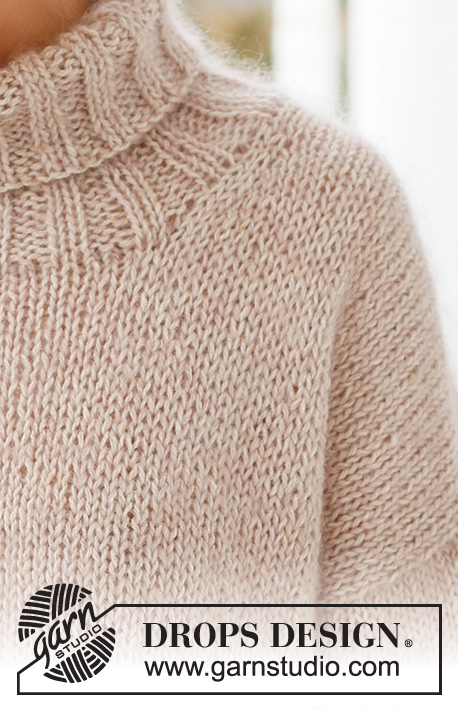



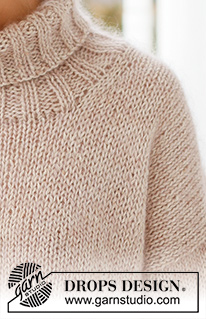

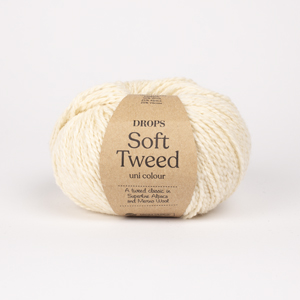


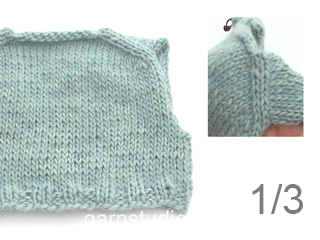
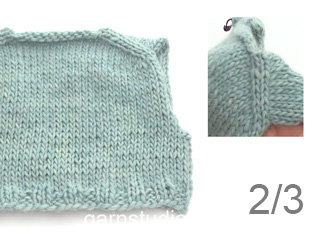
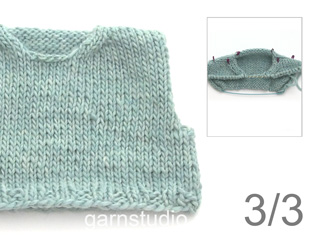























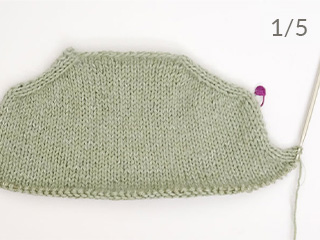
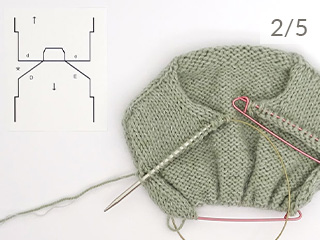
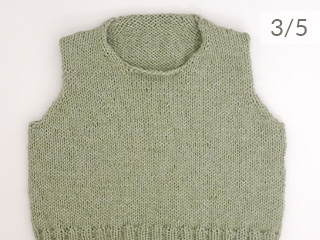

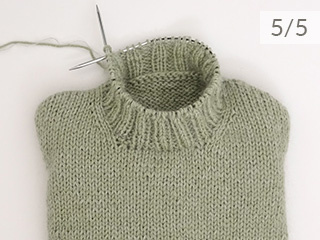























Comments / Questions (52)
Dzień dobry, jaki rozmiar ma na sobie modelka że zdjęcia?
15.10.2022 - 20:21DROPS Design answered:
Witaj Weroniko, modelka na zdjęciu nosi rozmiar S lub M. Zobacz kurs DROPS TUTAJ, jak wybrać dla siebie odpowiedni rozmiar. Pozdrawiamy!
17.10.2022 - 08:19Guten Tag, ich würde den Pullover gerne mit Rollkragen Stricken, geht das? Wenn ja, wie gehe Ichform. Vielen Dank für Ihre Mühe Birgit
11.10.2022 - 14:59DROPS Design answered:
Liebe Frau Büscher, diese Anleitung enthält einen Rollkragen, wenn Sie ihn aber noch länger möchten, stricken Sie einfach länger - den Pullover können Sie dann anziehen um die Länge vom Kragen anzupassen. Viel Spaß beim stricken!
11.10.2022 - 16:03Holder på med denne nå, og blir veldig usikker på hvor øverst på skulderen er -i forhold til hvor lang den skal strikkes?
09.10.2022 - 21:35DROPS Design answered:
Hei Anita, Du måler fra toppen av skulderen (ved siden av halsen), hvor skulderen er høyest. God fornøyelse!
10.10.2022 - 06:48Bonjour, il me manque un élément de précision s'il vous plait: Devant, dernière ligne "tricotez en jersey en AR jusqu'à ce que l'ouvrage mesure 26cm (pour ma taille) le long de l'emmanchure": quel est le point de départ de la mesure, à partir de ce rang ou à partir du haut de l'emmanchure du devant? Merci par avance pour votre retour.
07.10.2022 - 09:37DROPS Design answered:
Bonjour Laurence, mesurez sur le côté, le long de l'emmanchure devant, c'est à partir des mailles relevées sur le côté, mais bien le long de ce côté (pas niveau encolure ni au milieu). Bon tricot!
07.10.2022 - 13:52I want to knit the same sweater from Drops Andes or Wish yarn, what stitches calculation should I do please?
06.10.2022 - 10:40DROPS Design answered:
Dear Ineses, this pattern cannot be worked with a yarn group E such as Andes or Wish, you will have to work with a yarn group D such as Melody - see other possible combinations for 14 sts = 10 cm here. Read more about alternatives here. Happy knitting!
06.10.2022 - 11:31Bonjour, Pour être certain avant de commander :) pour une taille M, il faut bien 7pelotes de DROPS SOFT TWEED ? Merci de votre réponse
26.09.2022 - 09:17DROPS Design answered:
Bonjour Stéphanie, il faut effectivement 7 pelotes DROPS Soft Tweed + 4 pelotes DROPS Kid-Silk de chaque couleur (8 au total), en taille M - vous tricotez avec 3 fils (1 Soft Tweed + 2 Kid-Silk, 1 de chaque couleur), pensez à bien vérifier votre tension - cf FAQ.) Bon tricot!
26.09.2022 - 11:37Je souhaiterais tricoter ce modèle dans des ton plus foncés. (pas de tons pastels). Pouvez-vous m'indiquer les associations possibles pour 1 fil soft tweed et 2 fils kid silk de deux tons de couleur différents. Merci
22.09.2022 - 22:04DROPS Design answered:
Bonjour Mme Quashie, pour toute aide et conseil dans le choix des couleurs, merci de bien vouloir directement contacter votre magasin DROPS, ce sera bien plus facile pour eux de pouvoir vous conseiller directement (même par mail ou téléphone) en fonction de ce que vous recherchez. Bon tricot!
23.09.2022 - 07:51Bonjour, quelle est l'aisance prévue pour ce modèle ? merci ! 19.09.2022 - 10:32 DROPS Design answered: Bonjour Sophie, pour savoir quelle taille tricoter, mesurez un vêtement similaire dont vous aimez la forme et comparez ces mesures à celles du schéma en bas de page, vous trouverez ainsi la taille correspondante. Retrouvez plus d'infos ici. Bon tricot! Bonjour, je m'excuse mais vous ne répondez pas à ma question : quelle est l'aisance prévue ?
20.09.2022 - 18:05DROPS Design answered:
Bonjour Sophie, parce que nous ne travaillons pas avec un système d'aisance, chacune va pouvoir ainsi choisir l'aisance qu'elle souhaite en fonction de sa propre morphologie en se basant sur un pull similaire qu'elle possède et qui lui plaît en se basant sur les mesures du schéma; si vous êtes entre 2 tailles, choisissez la plus petite si vous le le souhaitez un peu plus serré ou bien la plus grande si vous le voulez plus grand. Bon tricot!
21.09.2022 - 09:08A gdyby tak zacząć tył robić od nabrania 78 oczek (rozmiar S) i przerabiać od środkowych oczek metodą skróconych rzędów niemieckich?
19.09.2022 - 12:55DROPS Design answered:
Witaj Karolino, możesz zmodyfikować wzór, ale pamiętaj, że konstrukcja góry swetra będzie nieco inna. Powodzenia!
19.09.2022 - 14:58Witam, ile włóczki Wish potrzeba na ten sweterek? I jaki rozmiar drutów? Dziękuję Rozmiar M 16.09.2022 - 22:37
19.09.2022 - 10:39DROPS Design answered:
Witaj Moniko, na wszelki wypadek wzięłabym 650 g włóczki, gdyż sweter jest dosyć szeroki. Co do rozmiaru drutów to między 8 a 9 na część główną, a o 1 rozmiar mniejsze na ściągacze. Najpierw zrób próbkę i zobacz czy jest dokładnie taka jak we wzorze (14 oczek na szerokość i 16 rzędów na wysokość, dżersejem = 10 x 10 cm). Jeżeli masz za dużo oczek na 10 cm, użyj większych drutów. Jeżeli jest za mało oczek na 10 cm, użyj mniejszych drutów. Powodzenia!
19.09.2022 - 11:08